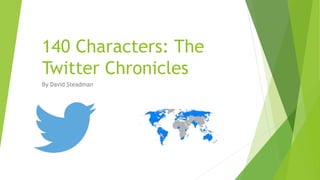140 characters the twitter story
- 1. 140 Characters: The Twitter Chronicles By David Steadman
- 2. How Twitter Saved London’s Air  Clean Air in London (@cleanairlondon) “is a non-profit organization that campaigns for sustainable air quality in London”.  Provides education about air quality and solutions to improve it
- 3. How it all began  Clear Air in London aimed to “extend the reach of their content and more rapidly grow their base of engaged followers.”  “Geo-targeting” was used to spread awareness to London’s twitter users.
- 4. How Other Twitter Users Pitched In  Word of London’s alarmingly high levels of “nitrogen dioxide” spread through twitter accounts operated by the “Mayor of London” (Boris Johnson), “BBC News”, and “The Guardian.”
- 5. The Outcome  @cleanairlondon was “successful” in its attempts to raise awareness.  Engagement rate of “19.4%”.  Over “two times as many followers”  Over “three times as many overall clicks”
- 6. Why it was a success  “Strong Message with tips and guidelines” to cultivate a “public understanding” of pollution.  “Targeting” the audience that would generate the best results.  “Personally” acknowledging retweets, favorites, and new followers.
- 7. Twitter to the Rescue
- 8. How it Happened  In 2012, New York Times reporter David Pogue had his iPhone stolen on a subway  After activating the tracking device, Pogue discovered that his phone traveled several miles to a “sketchy” suburb in Maryland.  He then posted these tweets to his 1.4 million Twitter followers:
- 9. How it Happened Cont.  Within “minutes” of the tweet being posted, several of his followers began searching.  One of those followers was a “police officer” in the town where the phone was emitting a signal.
- 10. How the Phone was found  After some searching, the iPhone was found lying in the “backyard” grass of a nearby home.  Initially, the homeowner denied taking the phone.  Later, he admitted to taking it in order to avoid criminal charges.
- 11. The Outcome  The iPhone was then sent back to David Pogue’s residence in Connecticut.  The story raised questions about user privacy  Mr. Pogue refuted the concerns, saying that the tracking device could only be activated with a password HE set.
- 12. SOURCES  Clean Air in London https://business.twitter.com/succ ess-stories/clean-air-London. 17 February 2015. Online.  Privacy in a Digital Age. http://www.pbs.org/newshour/bb /media-july-dec12-phone_08-03/. 18 February 2015. Online.  Images Provided by Creative Commons and Google Images











